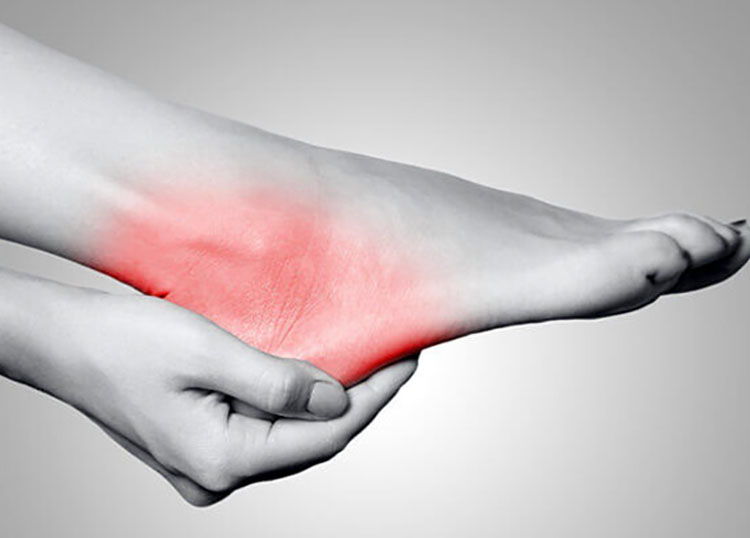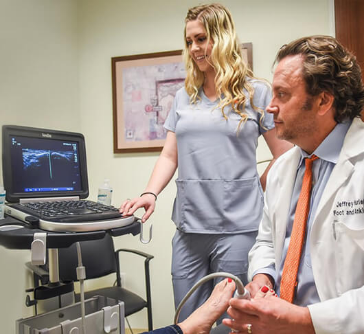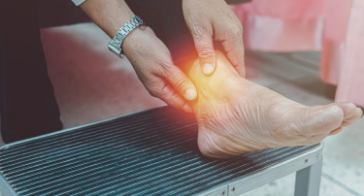
Schedule an Appointment
Heel pain is a common discomfort that often requires urgent care for foot pain, and can significantly impact daily activities. This pain is typically caused by the irritation of the ligament that runs along the foot's bottom and attaches to the heel. It can manifest in various areas of the heel, such as the front, back, or bottom, and is frequently a result of faulty biomechanics or excessive stress on the heel bone. Factors contributing to this stress include injury, walking or running on hard surfaces, unsuitable footwear, or being overweight. In some cases, a condition known as a heel spur, a calcium deposit on the heel bone's underside, can exacerbate the pain. This can be identified through an X-ray, showing a protrusion as much as half an inch. When heel pain does not improve with rest, particularly if it worsens after a night's sleep due to the stretching of the plantar fascia, it's crucial to seek foot heel pain treatment.
For effective heel pain treatment and relief, consulting an Urgent Care for Feet podiatrist is recommended if the pain persists beyond a month. The podiatrist may suggest various conservative treatments, including stretching exercises, physical therapy, and customized shoe inserts or orthoses. These treatments are integral to managing and alleviating heel pain. Heel cushions and pads, as well as cushioned shoes with an elevated heel, can also be beneficial in reducing pressure and providing relief. Dr. Hurless specifically recommends the 3/4 length Powerstep supports as an affordable and effective alternative to custom orthotics for those seeking urgent care for foot pain. These supports can offer significant relief and are a viable option for many patients struggling with persistent heel pain.
It's crucial to understand the importance of early intervention in managing these conditions. People often delay urgent care for foot pain, which can lead to the exacerbation of symptoms and more complex treatment requirements. Understanding the causes and effective management strategies for heel pain can make a significant difference in the quality of life and mobility.
Lifestyle modifications play a vital role in both the treatment and prevention of heel pain. For instance, maintaining a healthy weight can significantly reduce the stress on the heel and the associated ligaments. Additionally, choosing the right footwear is essential. Shoes that provide adequate arch support and cushioning can help in preventing and alleviating heel pain. Activities that put excessive stress on the heel, such as prolonged standing, running on hard surfaces, or wearing high heels, should be minimized.
Furthermore, incorporating regular foot exercises into one’s daily routine can strengthen the foot muscles and ligaments, reducing the risk of heel pain. Simple exercises like toe stretches, calf stretches, and towel stretches are beneficial in keeping the plantar fascia limber, thus aiding in foot heel pain treatment.
For persistent cases, more advanced treatments may be necessary. It’s essential to consult with a healthcare professional specializing in foot care to determine the best course of action for your specific condition. Remember, timely and appropriate treatment is key to managing heel pain effectively and ensuring a swift return to normal activities.

Meet The Specialist
We practice a minimally invasive approach to your foot or ankle problem with surgery as the last option.
Choose a Location Nearest You
Why Urgent Care for Feet

We can treat 90% of cases seen in an emergency room for a fraction of the cost.

All of our doctors have on average 15+ year of experience specializing in foot and ankle care.

We provide on site x-ray that is designed specifically for foot and ankle. This will avoid re-taking an x-ray done improperly at an ER or standard Urgent Care.
Frequently Asked Questions
Heel pain is often caused by overuse, injury, or conditions such as plantar fasciitis or Achilles tendinitis.
Plantar fasciitis is inflammation of the plantar fascia, the thick band of tissue on the bottom of the foot that causes heel pain.
Heel pain is diagnosed through a physical examination, patient history, and sometimes imaging tests like X-rays.
Preventive measures include wearing supportive shoes, stretching the feet, maintaining a healthy weight, and avoiding overexertion.
Treatments include rest, ice, anti-inflammatory medications, physical therapy, orthotics, and in severe cases, surgery.
Recovery time varies, but most people improve within a few weeks to a few months with proper treatment.
Untreated heel pain can lead to chronic pain, limping, and foot, knee, hip, or back problems.
See a doctor if heel pain persists, worsens, or affects daily activities.
Heel pain can often be cured with treatment, but some chronic conditions may cause recurring pain.
In rare cases, heel pain can indicate a more serious condition like a bone fracture or infection.
Lifestyle changes like regular exercise, proper footwear, and weight management can help manage heel pain.
Yes, frequently wearing high heels can contribute to heel pain and other foot problems.
Heel pain is more common in middle-aged individuals, but can occur at any age.
Yes, custom orthotics can help alleviate heel pain by providing proper foot support.
Heel pain often increases with activity, especially after long periods of rest or in the morning.
Reviews
This place was the best. Last night I stubbed my toe in the middle of the night and I wasn’t sure if it was broken. I couldn’t even walk. I called and they got me in right away. They took x-rays and put me in a boot because my toe was broken. The office was great and they special in feet yay!
![]()
Caitlyn Meyer
I stepped on a piece of glass and thought I had removed it but every time I stepped down I could feel it. I called Urgent Care For Feet and was seen same day and the doctor removed the glass and the whole staff was great.
![]()


